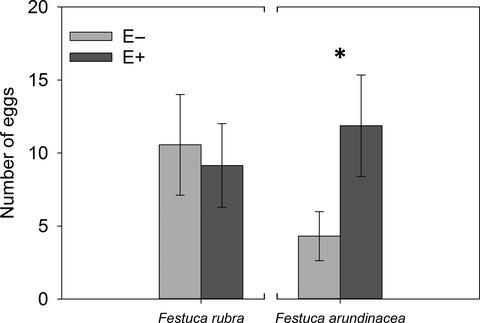当前位置:
X-MOL 学术
›
Ecol. Evol.
›
论文详情
Our official English website, www.x-mol.net, welcomes your
feedback! (Note: you will need to create a separate account there.)
Insect oviposition preference between Epichloë-symbiotic and Epichloë-free grasses does not necessarily reflect larval performance.
Ecology and Evolution ( IF 2.3 ) Pub Date : 2020-06-01 , DOI: 10.1002/ece3.6450 Miika Laihonen 1 , Kari Saikkonen 1 , Marjo Helander 2 , Toomas Tammaru 3
Ecology and Evolution ( IF 2.3 ) Pub Date : 2020-06-01 , DOI: 10.1002/ece3.6450 Miika Laihonen 1 , Kari Saikkonen 1 , Marjo Helander 2 , Toomas Tammaru 3
Affiliation

|
Variation in plant communities is likely to modulate the feeding and oviposition behavior of herbivorous insects, and plant‐associated microbes are largely ignored in this context. Here, we take into account that insects feeding on grasses commonly encounter systemic and vertically transmitted (via seeds) fungal Epichloë endophytes, which are regarded as defensive grass mutualists. Defensive mutualism is primarily attributable to alkaloids of fungal origin. To study the effects of Epichloë on insect behavior and performance, we selected wild tall fescue (Festuca arundinacea ) and red fescue (Festuca rubra ) as grass–endophyte models. The plants used either harbored the systemic endophyte (E+) or were endophyte‐free (E−). As a model herbivore, we selected the Coenonympha hero butterfly feeding on grasses as larvae. We examined both oviposition and feeding preferences of the herbivore as well as larval performance in relation to the presence of Epichloë endophytes in the plants. Our findings did not clearly support the female's oviposition preference to reflect the performance of her offspring. First, the preference responses depended greatly on the grass–endophyte symbiotum. In F. arundinacea , C. hero females preferred E+ individuals in oviposition‐choice tests, whereas in F. rubra , the endophytes may decrease exploitation, as both C. hero adults and larvae preferred E− grasses. Second, the endophytes had no effect on larval performance. Overall, F. arundinacea was an inferior host for C. hero larvae. However, the attraction of C. hero females to E+ may not be maladaptive if these plants constitute a favorable oviposition substrate for reasons other than the plants' nutritional quality. For example, rougher surface of E+ plant may physically facilitate the attachment of eggs, or the plants offer greater protection from natural enemies. Our results highlight the importance of considering the preference of herbivorous insects in studies involving the endophyte‐symbiotic grasses as host plants.
中文翻译:

昆虫在与Epichloë共生和无Epichloë的草之间的产卵偏好并不一定反映幼虫的表现。
植物群落的变化可能会调节草食性昆虫的摄食和产卵行为,而与植物相关的微生物在这方面很大程度上被忽视。在这里,我们考虑到以草为食的昆虫通常会遇到系统性和垂直传播(通过种子)的真菌Epichloë内生菌,它们被视为防御性草互利共生体。防御性互利共生主要归因于真菌来源的生物碱。为了研究Epichloë对昆虫行为和性能的影响,我们选择了野生高羊茅( Festuca arundinacea )和红羊茅( Festuca rubra )作为草类内生菌模型。使用的植物要么含有内生菌(E+),要么不含内生菌(E−)。作为模型草食动物,我们选择了以草为幼虫的Coenonympha 英雄蝴蝶。我们检查了草食动物的产卵和取食偏好,以及幼虫的表现与植物中存在的Epichloë内生菌的关系。我们的研究结果并没有明确支持雌性的产卵偏好来反映其后代的表现。首先,偏好反应很大程度上取决于草-内生菌共生体。在F. arundinacea中, C. Hero雌性在产卵选择测试中更喜欢 E+ 个体,而在F. rubra中,内生菌可能会减少剥削,因为C. Hero成虫和幼虫都喜欢 E- 草。其次,内生菌对幼虫的生长性能没有影响。总体而言, F. arundinacea是C. Hero幼虫的劣等宿主。然而, C.的吸引力。如果这些植物由于植物营养品质以外的原因构成有利的产卵基质,那么 E+ 的英雄雌性可能不会适应不良。例如,E+植物的较粗糙表面可能在物理上有利于卵的附着,或者植物提供了针对天敌的更大保护。我们的结果强调了在涉及内生菌共生草作为寄主植物的研究中考虑食草昆虫偏好的重要性。
更新日期:2020-07-30
中文翻译:

昆虫在与Epichloë共生和无Epichloë的草之间的产卵偏好并不一定反映幼虫的表现。
植物群落的变化可能会调节草食性昆虫的摄食和产卵行为,而与植物相关的微生物在这方面很大程度上被忽视。在这里,我们考虑到以草为食的昆虫通常会遇到系统性和垂直传播(通过种子)的真菌Epichloë内生菌,它们被视为防御性草互利共生体。防御性互利共生主要归因于真菌来源的生物碱。为了研究Epichloë对昆虫行为和性能的影响,我们选择了野生高羊茅( Festuca arundinacea )和红羊茅( Festuca rubra )作为草类内生菌模型。使用的植物要么含有内生菌(E+),要么不含内生菌(E−)。作为模型草食动物,我们选择了以草为幼虫的Coenonympha 英雄蝴蝶。我们检查了草食动物的产卵和取食偏好,以及幼虫的表现与植物中存在的Epichloë内生菌的关系。我们的研究结果并没有明确支持雌性的产卵偏好来反映其后代的表现。首先,偏好反应很大程度上取决于草-内生菌共生体。在F. arundinacea中, C. Hero雌性在产卵选择测试中更喜欢 E+ 个体,而在F. rubra中,内生菌可能会减少剥削,因为C. Hero成虫和幼虫都喜欢 E- 草。其次,内生菌对幼虫的生长性能没有影响。总体而言, F. arundinacea是C. Hero幼虫的劣等宿主。然而, C.的吸引力。如果这些植物由于植物营养品质以外的原因构成有利的产卵基质,那么 E+ 的英雄雌性可能不会适应不良。例如,E+植物的较粗糙表面可能在物理上有利于卵的附着,或者植物提供了针对天敌的更大保护。我们的结果强调了在涉及内生菌共生草作为寄主植物的研究中考虑食草昆虫偏好的重要性。










































 京公网安备 11010802027423号
京公网安备 11010802027423号